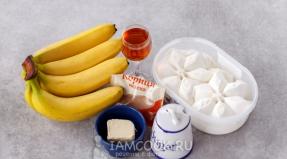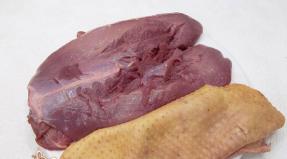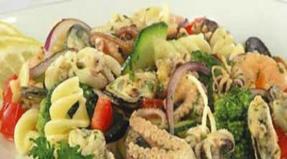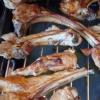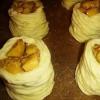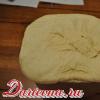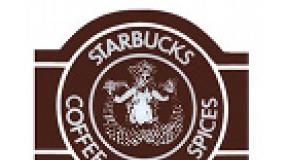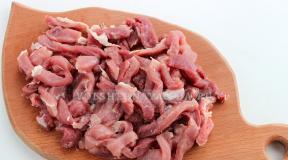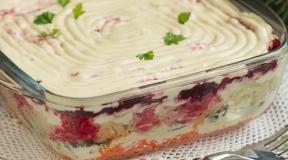Artos: Easter bread. Paasbrod - Dutch Easter bread
What is the name of Easter bread? You will learn the answer to this question from the materials of the presented article. We will also tell you about how such pastries are made at home.
general information
An invariable attribute of such happy holiday like Easter is traditional pastries. Grandmothers and Easter cakes - without them it is quite difficult to imagine a real one. Along with them modern housewives They also make pastries such as Easter bread. It fits perfectly into the format of this holiday.
Artos (emphasis on the first syllable) is the consecrated bread of the Easter week, made from a yeast base. The tradition of its preparation quite strongly influenced Easter cuisine all Orthodox peoples.
The classic artos is prepared with the image of a cross, on which only one is visible. This symbolizes the resurrection of Christ, his victory over death.
In the Russian community, church Easter bread is a high pastry.
Artos can be cooked at home different ways. Sometimes housewives give baked goods an unusual shape and call it Easter bread. Such a product has great taste. It can serve as an ideal decoration for a festive table. But for this you need to show a little imagination.
Excellent compositions are obtained from such bread when combined with small pastries or colored eggs. Although these are just a few of the many various options which you can choose according to your choice.

Delicious Easter Bread: Cooking Recipe
Despite the external complexity, such baking is done easily and simply. To make it lush and soft, you should use only fresh and suitable products.
So, for Easter bread we need:
- wheat flour - from 450 g;
- granulated sugar - from 1.5 large spoons;
- table salt - an incomplete dessert spoon;
- dry yeast - 5 g;
- whole milk and warm water - ½ cup each;
- butter - approximately 60 g;
- sesame seeds - use for sprinkling the semi-finished product.
Knead the dough
The dough for such bread should be made only rich yeast. To knead it, use a mixture and warm drinking water. They are combined in one bowl, and then sugar is added and mixed well. After sweet product dissolve, spread in the dishes and leave the ingredients completely alone. After ¼ hour, they should swell well.
Having prepared the yeast mixture, a very soft butter. Mix the ingredients with your hands and add wheat flour to them. This product should be poured until you get a homogeneous and elastic dough. It is covered with a rag, closed with a lid and left in a warm room for 80-90 minutes. As a result of such exposure, you should get a lush and soft base. To make it more porous, it is periodically whipped with your hands.

Beautiful bread shaping process
Easter bread can be shaped in many ways. Someone makes it in the form of a cross with a wreath of thorns, and we decided to give baking a more convenient shape for eggs. Thus, it was decided to form the bread in the form of a kind of nest.
To implement the plan, it is necessary to use a large and round heat-resistant form. It is well lubricated with oil, and then set in the middle part of the bowl, after turning it upside down. It should be noted that the diameter of this dish should be half the size of the main form.
After the inventory is prepared, proceed to the formation of a semi-finished product. To do this, take a small piece of dough and roll it into a round layer 0.8 centimeters thick. Then it is laid out on top of an inverted bowl. Next, the remaining base is divided into 7 parts and identical balls are formed from them. They are placed in the space between the sides of the heat-resistant form and the bowl.
After that, the laid out layer is not completely cut into 7 parts. The resulting petal-segments are opened, slightly pulling the corners. By placing them on spherical semi-finished products, they form a kind of flower.
After the described actions, the inverted bowl is carefully removed. As for bread, it is greased either sunflower oil, or cooking oil or egg yolk. At the end, the semi-finished product is sprinkled with sesame seeds.

Heat treatment process
Easter bread is not baked in the oven for very long.
After the semi-finished product is ready, it is kept warm for 10 minutes. Then the product is placed in a preheated oven. At 200 degrees sweet pastries cooked for 55 minutes. During this time, Easter bread will increase in volume, become fluffy and rosy. In this case, the hole in the middle of the product should either significantly decrease, or completely disappear and tighten.
Serve delicious pastries for the Easter table
After the bread is baked in the oven, it is taken out and hot greased with butter. This will make it more fragrant, soft and tasty. Before serving to the festive table, they spread in the recess in the bread
Outwardly, such pastries very much resemble a nest.
Summing up
Despite the fact that the process of preparing Easter bread takes a lot of time (for kneading the dough, keeping it warm, shaping and baking), such a product of the hostess is baked quite often, especially for the Easter holidays.

If you have your own ideas on how to form rich pastries, then you can safely implement them into the culinary process.
Artos is an Easter bread that is made and given to people only once a year, then cherished as long as possible after the end of the celebration. True believers know that, in addition to the attributes of a sacred holiday that are widespread in the world, this is another important symbol of Easter.
Easter is one of the main Christian holidays, during which grand processions are held, bells ring in churches, joy and fun reign. Even people who are far from religion know that on this day it is customary to paint eggs, eat Easter cakes and answer the Easter greeting “Christ is Risen” from childhood with the well-known words “Truly Risen”.
"Artos" (pronounced with emphasis on the first syllable) in Greek means "bread". In Orthodoxy, this is pickled, sour bread consecrated on Easter week. His recipe has been passed down from generation to generation. He is the whole prosphora (without parts removed from it for the proskomidia - the first part of the liturgy, during which pieces are taken out of the prosphora in memory of the Saints, as well as for the repose and health of the laity), otherwise - a single member of the Church.
Easter bread, which is distributed in the Orthodox Church, looks like a tall top hat. It consists of two parts: a three-dimensional base and a flat cover, on which a cross and a wreath of thorns are depicted. Christ crucified on the cross is absent, as a symbol of the fact that He conquered death. Sometimes the letters XB are applied to the artos - an abbreviation of the phrase "Christ is risen."
The first written mention of what an artos is appeared at the beginning of the 12th century. And the appearance of this bread, revered in the church, is attributed to those ancient times when the Savior ascended to heaven. Thinking about Him, about every word, deed and action performed by the Lord, the followers and disciples of Jesus consoled themselves day by day with prayers and memories, learned to accept the earthly world without Him. But during the meal, the Apostles did not dare to take the main place at the table and eat without their spiritual mentor, but left a place for the invisibly present Lord, laying out bread for Him.
The servants of the temple, imitating the disciples of Christ, laid bread in the temple for the celebration of Easter. They expressed the idea that the Savior, having accepted torment to atone for the sins of mankind, went to heaven, but his personification and symbol of life remained - the artos.
Consecration and use of church bread
Artos, consecrated on the first day of Easter, occupies an important place in the celebration. At the end of the liturgy, through the pronunciation of a special prayer (called the ambo, because to read it the priest descends from the altar behind a ledge called the ambo, or stops on it), the sacrament of the consecration of the artos takes place, one or when many are prepared - all at once. At the end of the ritual, the bread is sprinkled with holy water and blessed in accordance with all the ceremonies adopted.
Throughout the celebration of Easter, the artos is located in front of the Royal Doors. During the service, he is placed in front of the icon of the Savior, so as not to impede the passage through the gates of the clergy. Every Easter procession, Easter bread is carried around the temple.
On Bright Saturday, when the liturgy ends, the artos is crushed. For this, a special prayer is read, addressed to the Savior with gratitude for the fact that he satisfies the hunger of needy people with bread, and praising his wisdom and forgiveness
After the ceremony and the kissing of the Cross, parts of the bread are distributed to the people as a shrine. It is customary to eat the resulting pieces of arthos only in exceptional cases: in case of illness or serious spiritual problems.
They use holy bread on an empty stomach, after praying with a request for help addressed to the Lord. They keep it near the icons. And in case of spoilage, you can burn the product, put it in a clean stream or take it back to the church so that the priest can perform the ritual of destroying the holy food in accordance with all the rules.
Artos recipe at home
Quite often, housewives make their own changes to the arthos preparation process so that it is tastier or easier to make. Beautifully decorated and served on the table, calling this pastry Easter bread. But real artos must be made according to the old method approved by the clergy, and then it must be consecrated in the temple. Here is the cooking recipe given by the monks.
True Bread Ingredients:
- flour coarse grinding- 1200 g;
- boiled water - 1 glass;
- holy water - 1 glass;
- salt - 30 g;
- yeast - 30 g
The cooking process will not cause any particular difficulties.
| Stages of work | Subtleties |
| Pour half of the holy water into the bowl for kneading the dough, add 400 g of flour. | Pour boiling water over to ensure that in the future the Easter bread is sweet and resistant to staleness. |
| Stir, cool, then add yeast and salt. | Dilute salt in advance in holy water and thus pour into the mixture. |
| Mix the resulting mass thoroughly and leave to rise. | Wait half an hour. |
| Then add the remaining flour and knead the dough. | After waiting for it to fit, roll it out. |
| Form two parts - the lower (volumetric) and the upper (almost flat). | Place a seal with the image of a cross and a wreath on the upper part. |
| Connect them together with water and put to bake. | Bake at 180 degrees for 15-20 minutes. |
Let the finished products stand for an hour, after which they can be put away in a place specially prepared for them.
Imitating the Apostles, the first pastors of the Church established on the feast of the Resurrection of Christ to lay bread in the temple, as a visible expression of the fact that the Savior who suffered for us has become for us the true bread of life. This bread is called ARTOS.
Word artos (translated from Greek - leavened bread) - consecrated bread common to all members of the Church, otherwise - whole prosphora.
Throughout the entire Bright Week, Artos occupies the most prominent place in the temple, along with the image of the Resurrection of the Lord, and, at the conclusion of the Easter celebrations, is distributed to believers.
Artos has been used since the very beginning of Christianity. On the fortieth day after the Resurrection, the Lord Jesus Christ ascended into heaven. The disciples and followers of Christ found comfort in prayerful memories of the Lord - they remembered His every word, every step and every action. When they came together for a common prayer, they, remembering the Last Supper, partake of the Body and Blood of Christ. Preparing an ordinary meal, they left the first place at the table to the invisibly present Lord and put bread on this place.
Imitating the Apostles, the first pastors of the Church established on the feast of the Resurrection of Christ to lay bread in the temple, as a visible expression of the fact that the Savior who suffered for us has become for us the true bread of life. The artos depicts a cross, on which only the crown of thorns is visible, but there is no Crucified One - as a sign of Christ's victory over death, or an image of the Resurrection of Christ. An ancient church tradition is also connected with the artos, that the Apostles left a piece of bread at the table - a share of the Most Pure Mother of the Lord as a reminder of constant communion with Her - and after the meal they reverently shared this part among themselves. In monasteries, this custom is called the Chin o Panagia, that is, the remembrance of the Most Holy Mother of the Lord. In parish churches, this bread of the Mother of God is remembered once a year in connection with the fragmentation of the arthos.
The artos is consecrated by a special prayer, sprinkling with holy water and censing on the first day of Holy Pascha at the Liturgy after the pulpit prayer. On the salt, against the Royal Doors, on the prepared table or lectern, an artos is placed. If several artos are prepared, then all of them are consecrated at the same time. After censing around the table with the artos installed, the priest reads a prayer: “God Almighty and Lord Almighty, even Thy servant Moses in the exodus of Israel from Egypt, and in the liberation of Thy people from the bitter work of Pharaoh, Thou commanded to slaughter the lamb, foreshadowing on the Cross the slain by the will of us for the sake of Lamb, who takes away the sins of the whole world, Thy beloved Son, our Lord Jesus Christ! And now, we humbly pray to Thee, look at this bread, and bless, and sanctify it. For we too, Thy servants, in honor of I glory, and in remembrance of the glorious Resurrection of the same Son of Thy Lord our Jesus Christ, who from the eternal work of the enemy and from hellish indeterminate bonds, permission, freedom and conduct of the good, before Your Majesty now in this all-bright, glorious and saving day of Pascha, this we bring: we who bring this, and that kiss and eat from it, partakers of Your heavenly blessing to be, and all sickness and disease from us with Your power of rejection, giving health to everyone. You are the source of blessing and giver of healing, and we send glory to You to the Beginningless Father, with Your Only Begotten Son, and Your Most Holy and Good and Life-Giving Spirit, now and ever and forever and ever.
After the prayer, the priest sprinkles the artos with holy water, saying: “This artos is blessed and sanctified by sprinkling this sacred water, in the name of the Father and the Son and the Holy Spirit. Amen" (three times). The lectern with the artos is placed on the salt in front of the image of the Savior, where the artos lies throughout the Holy Week. It is preserved in the temple throughout Bright Week on a lectern in front of the iconostasis. On all days of Bright Week, at the end of the Liturgy, a procession around the church is solemnly performed with the artos.

On Saturday of Bright Week, according to the prayer behind the ambo, a prayer is read for the fragmentation of the artos: “Lord, Jesus Christ, our God, the Bread of the Angels, the Bread of Eternal Life, descended from Heaven, nourishing us in these bright days with the spiritual food of Your Divine good deeds, for the sake of the three-day and saving Resurrection ! Look now, we humbly pray to Thee, to our prayers and thanksgiving, and as if you blessed five loaves of bread in the desert, and now bless this bread, as if all who eat from it, bodily and spiritual blessings and health will be honored with the grace and bounty of Your philanthropy. Thou art our sanctification, and we send glory to Thee, with Your Father without beginning, and the All-Holy, and the Good, and Your Life-giving Spirit, now and forever, and forever and ever.
Artos is broken up and at the end of the Liturgy, when the Cross is kissed, it is distributed to the people as a shrine. You need to use Artos on an empty stomach, with holy water, and with prayer and reverence.
The arthos genus on the lower degree of consecration represents Easter cake, church-ceremonial food, but not worldly luxury at all.
![]()
Our Russian Easter cakes are called Easter bread abroad. It turns out that only we bake such pastries for Easter. Orthodoxy invented many of its own traditions and rituals, and therefore festive table at Easter, the Orthodox differ from other Christian traditions. How can you imagine Easter without the usual Easter cakes and colored eggs? This tradition has not changed for centuries and is so dear to us! On the eve of the great Christian holiday of Easter, everyone is looking for new or old and tested recipes to cook unusual table. The recipe for this Easter bread is quite simple, in fact, it is the most ordinary Easter cake which our great-grandmothers baked in the oven in the village. Today we remember their recipes and implement them in our modern conditions. You can add any of your favorite dried fruits or candied fruits to the dough and add a little more sugar if you like sweet cakes. For those who like not very sweet Easter cakes, to eat them instead white bread, the recipe will do as it is. Unsweetened Easter bread or can also be used for sandwiches. The ingredients are for 2 large cookies.
Russian Easter bread ingredients.
Milk - 1 tbsp.
Sugar - 0.5 tbsp.
Butter - 150 g
Yeast active, dry - 2.5 tsp
Warm water - 0.25 tbsp.
Salt - 2 tsp
Saffron - a pinch
Flour - 6 tbsp.
Eggs - 4 pcs.
How to cook Russian Easter bread.
1. Make dough. Heat butter, sugar, milk and saffron in a saucepan until butter is completely melted and sugar is dissolved. In the meantime, make a brew. Dissolve the yeast in warm water and add a pinch of sugar. Let sit for a bit and start foaming. After 5 minutes, the mixture should look like foam and increase slightly. If this does not happen, repeat the process with other yeast, perhaps these are unsuitable. Pour flour into a deep bowl. Make a well in the center of the flour. Beat in 3 eggs and add the milk and yeast mixture. Gently knead the dough with a wooden spoon so that the flour is completely dispersed and the dough is soft. Then transfer the dough to a floured worktop and knead the dough with your hands, dusting with flour from time to time to keep the dough from sticking. Knead the dough for about 10 minutes until elastic. Then transfer the dough to a deep, clean bowl greased with butter. Roll a ball of dough in this oil in a bowl and cover with a clean towel. Leave to rise in a warm, draft-free room for 3 hours. The dough should double in size. After that, once again sweep the dough, it will fall. Cover again with a towel and leave to rise again for 1 hour.
2. Transfer the dough to the molds. You can use 2 tall cake tins for this Easter bread big size, as well as a few small soufflé molds. Grease the molds with butter. Divide the dough into equal parts and place in the mold two-thirds of its height. You can make pigtails or other decorations from pieces of dough and decorate Easter cakes with them. Cover the molds with a clean towel and let stand in a warm place for another 1.5 hours. The dough will still rise.
3. Baking. Preheat oven to 175 degrees. Beat the remaining egg with a pinch of salt and brush the surface of the cakes with it. Place the grate on the lower level. Put the molds in the oven and bake for about 1 hour until the cakes are browned. Then take them out of the mold and cool on a wire rack.
The dough can be prepared ahead of time. The dough prepared in 1 day can be stored in the refrigerator, wrapped in cling film. Frozen dough will keep for 2 weeks.
Bon Appetit!
Material belongs to the site
Recipe author Natalia Seledtsova
Preparing another one Easter baking, but this time it's not a cake at all. I offer a recipe for Paasbrod - Dutch sweet bread, which is usually baked for Easter. A fragrant yeast dough is waiting for you, generously flavored with candied fruits, raisins and nuts, inside of which is hidden delicious stuffing from marzipan. For real holiday baking - worthy decoration Easter table!
Paasbrod is a fragrant pastry shaped like loaves that closely resembles the German Christmas stollen. True, unlike the latter, in the composition of this Dutch bread, the weight of filler additives exceeds the weight wheat flour. In addition, the fragrant marzipan filling complements the already delicious yeast dough, making Paasbrod a true delicacy.
In total, this recipe requires 550 grams of filler. I opted for colorful candied pineapple, pitted raisins and shelled walnuts. You can easily change the composition and add those goodies that you like best. Dried apricots, prunes, dried berries (cranberries, cherries), any other nuts - it is important that you end up with 550 grams.
Orange juice is an excellent substitute for fragrant strong alcohol(rum, cognac, brandy, liqueurs). Marzipan can be easily prepared by yourself from sweet almonds, powdered sugar, egg white and food flavoring- . In addition, you can flavor the dough with citrus zest or your favorite spices, which will undoubtedly enrich taste qualities finished Paasbrod.
Ingredients:
Yeast dough:
(500 grams) (250 milliliters) (50 grams) (1 piece ) (1 tablespoon ) (7 grams) (0.25 teaspoon)
Additives:
Filling:
Lubrication and dressing:
Cooking step by step with photos:

To make Dutch Easter bread, we need wheat flour premium, milk of any fat content (I have 2.5%), high-quality butter (at least 72% fat), medium-sized chicken eggs (45-50 grams each), powdered sugar and vanilla sugar, candied fruits, raisins, peeled Walnut, orange juice, yeast, chicken eggs, salt. In addition, for the filling, take marzipan and egg yolks, grease the blanks with a mixture of milk and egg yolk.

In a large bowl, sift (preferably twice) premium wheat flour. Due to this, the flour will not only loosen and be saturated with oxygen, but possible debris will also leave. You may need a little less or more flour - it depends on its quality (in particular moisture content). That is why I would advise you not to use all the flour at once, but to start with 450 grams - then you will be guided by the consistency of the dough.

Add to flour fast acting yeast(6 grams - 2 teaspoons under the knife), vanilla sugar and salt. Mix everything thoroughly with a fork or whisk. About yeast: it is not necessary to take high-speed ones - just dry (also 6 grams) or pressed (you need 3 times more, that is, 18 grams) are perfect. Such yeast is not immediately mixed with flour, but is pre-activated in a warm, sweetish liquid for 10-15 minutes. In our case, you can slightly warm half a glass of milk with vanilla sugar and dissolve the yeast in it.

V flour mixture make a deepening and pour warm (not hot, but pleasantly warm) milk into it, break a couple chicken eggs. Mix everything with your hand or a spoon so that the flour is moistened.

When you get such flour lumps, you can introduce soft butter (take it out of the refrigerator in advance and leave it to soften on the table). We start kneading the dough with our hands or with the help of a dough mixer (bread machine).

You need to knead this yeast dough for quite a long time - at least 10 minutes, and even better longer. As a result, you will get a smooth, completely homogeneous dough. It should be soft and not at all sticky. At the same time, the yeast dough keeps its shape perfectly, it is quite elastic and elastic. As I wrote above, during the kneading process, you may need a little more or a little less flour than I indicated in the ingredients (I needed exactly 500 grams for the dough) - it depends on its moisture content. We roll the dough into a ball and leave it in a bowl (I always wash the dishes in which the dough roams - I just don’t like dirty ones). We send the dough to heat for 1 hour.

While the dough is fermenting, make the filling. To do this, you just need to combine marzipan with egg yolks.



Rinse pitted raisins, dry and fill with freshly squeezed orange juice(or flavored alcohol). If the raisins are soft enough, do not soak them for a long time (5-10 minutes is enough for soft ones), otherwise they will soften (this is exactly what happened to me, but more on that later).

Along the way, cut multi-colored candied fruits into small cubes. Be sure to sort out the peeled walnuts and chop them with a knife quite large pieces. This time I got a little excited and crushed the nuts a lot (this is the second point, which I will discuss below). By the way, I strongly advise you to pre-fry the nuts in a dry frying pan, then they will be crispy and more fragrant.

After about 1 hour, the yeast dough should rise very well. For me, it grew a lot after 50 minutes and increased in volume by 5 times (quality yeast was caught). A bit of traditional lyrics for those who first came to visit me: where better than dough wander and what does a warm place mean? There are several options. First of all, in the oven with the light on (it turns out about 28-30 degrees - ideal for fermentation yeast dough temperature). Then we tighten the bowl with the dough cling film or cover with a towel natural fabric(flax is best) so that the surface does not wind and crust. You can also let the dough ferment in microwave oven in which we first bring a glass of water to a boil. The dough will rise with the door closed, and the glass will stand there. Then you don’t need to close the bowl with anything, as the water will evaporate, thereby maintaining the necessary humidity. Just make sure that no one inadvertently turns on the microwave, otherwise the dough will disappear and there will be no Easter bread.

At this stage, we will introduce fillers into the dough. We crush it and add nuts, candied fruits and raisins along with juice (or alcohol).

It is most convenient to mix the additives on the working surface, so put the dough on the table and start kneading. If necessary, add a little more wheat flour, if the dough is too sticky and smeared heavily on the table, just do not get carried away. When all the nuts and dried fruits are evenly distributed over the dough, we collect it into a ball, transfer it back to the bowl and let it rest in the heat for another 30-40 minutes. The photo shows that my dough has darkened: this is just due to the fact that the raisins are too soft - in part, they simply fell apart and became part of the dough. And also a small nut crumb also did its job, tinting the dough. This did not affect the taste in any way, but the pastries turned out to be not as light as they should be.

When there are 5-10 minutes left until the end of the fermentation of the dough, we take out the marzipan mass from the freezer. We divide it into 2 equal parts and roll each into a thick sausage. Since marzipan has cooled well and even partially frozen, it does not stick to hands so much and keeps its shape perfectly.


We turn to the molding of the future Easter bread Paasbrod. I baked 2 large loaves, so I divided the dough into 2 equal parts, rolling each into a bun. You can bake 3 or more smaller products (then divide the marzipan mass by the corresponding amount equal parts). work surface sprinkle with a small amount of wheat flour - I did not indicate the weight in the ingredients.
